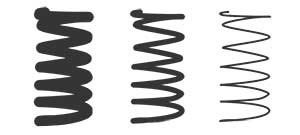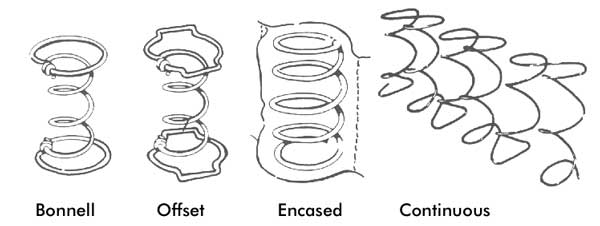A mattress is a mattress, right? Wrong! If you have ever shopped for a new bed, you already know how much there is to know about a mattress and it may have left you feeling a tad confused. Gel or memory foam? Firm or soft? Sleep number bed or not to sleep number bed? Should I get an adjustable base? How thick should the coil gauge be?
—Erp! You may have stopped there. Out of all of these options, choosing a coil gauge may be the most unfamiliar to you. We’re here to clear that up. By the end of this article, you will be a coil gauge master! …Okay, maybe not. But at the very least, more familiar with the term.
What is a Coil Gauge?
Coil gauge, in layman’s terms, is the measurement of the thickness of the wire used to make a mattress coil (you know, the little spirals inside an innerspring mattress?). Mattress coil gauges typically range between 12 and 15. A higher gauge number, like 15, means a thinner and softer, more gentle coil wire. A lower number, say 13 or 12, means a thicker and firmer gauge.
The gauge can also indicate a mattress’ durability as well. A lower gauge is likely to last longer because the thicker wire won’t wear out as fast, although most people replace their mattress before the coil system even wears out.
If you prefer a firm level of comfort, then you want a mattress with a gauge of 13 or lower. If you enjoy a mattress that is more forgiving, then go or a mattress with a coil gauge 14 or above.
While coil gauge can give you some information about how a mattress feels, it shouldn’t be your only focus as you try to find the ideal mattress. The comfort a mattress provides comes from a combination of the coil system and comfort materials. A mattress with a low coil gauge could have a pillow top or euro top and thus, feel a lot softer than some other mattresses with the same coil gauge.

Coil Configuration
Coil configuration is the pattern in which coils provide support in a mattress, and can change how a mattress feels as well as its ability to transfer motion.
The type of styles are:
- Bonnell – classic mattress performance
- Offset – classic mattress performance
- Continuous wire – keep their shape longer than mattresses with traditional
- Encased coils – provide body contouring support and reduce motion transfer

Coil Count
The coil count is the number of individual coils inside of a mattress. Higher coil counts provide better body support and increase mattress longevity.
Coil Count Requirement:
Full Mattress = 300 coils
Queen Mattress = 400 coils
King Mattress = 480 coils
Avoid mattress’ with a low coil count, but also know that mattresses with coil counts above the minimum standards don’t often see a difference in comfort or support. For example, if you purchase a full mattress with 400 coils, it won’t necessarily mean it’s more supportive than the required 300 count.
Some mattresses use extra layers of padding for edge protection, which reduces the actual number of coils inside. These mattresses usually promote coil density numbers, which indicate the level of support in comparison to coil count.
Can Coils Become… Fatigued?!
Coil fatigue can occurs in lower-quality mattresses at the center of a mattress when an innerspring coil loses load-bearing capacity. Once coils wear out, mattresses sag and this may create great discomfort and lower back pain.
Now that you are a coil gauge extraordinaire, go off into the sunset and find your perfect mattress! Wait. On second thought, not just yet. Coil gauge isn’t the only thing you should base your mattress on. In fact, it’s a combination of things. But don’t worry, the incredibly knowledgeable experts at LutherSales will help guide you through the mattress buying process. Call us today at 1-800-358-6466 and we’ll have you on your way to the kind of sleep you’ve been dreaming of.
If you liked this article, you’ll love:










